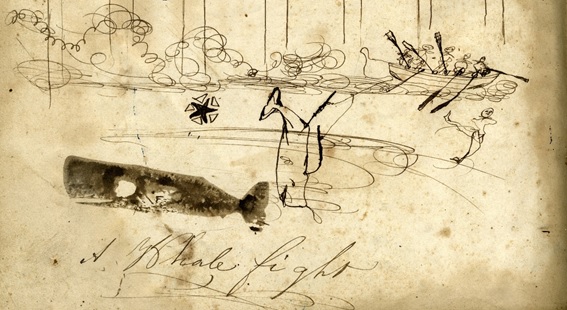The missing whales: relevance of “struck and lost” rates for the impact assessment of historical whaling in the southwestern Atlantic Ocean
Image: Drawing extracted from a logbook (Logbook Brunswick, © Alex Aguilar)
Whale populations are currently facing several human-related threats, being adversely affected by marine pollution, shipping traffic, overfishing, climate change and the overall degradation of habitats. However, direct hunting is undoubtedly the activity with the most dramatical effect on the status of these marine mammals. Dating back to the Neolithic age, whaling became a global-scale industrial activity in the 18th and 19th centuries and was regulated only a few decades ago, after having brought many whale populations to the edge of extinction.
Reconstructing the impact of whaling on cetacean populations is key to estimating their initial size and thus assessing the extent of their subsequent recovery and demographic trends, which, in turn, are necessary for their effective management and conservation.
In the current study, the authors dug into old whaling logbooks preserved in US and European public archives to extract information on the offshore open-boat whaling activities that took place in the southwestern Atlantic Ocean between the late 18th and the early 20th centuries. Looking into the numbers of sperm whales (Physeter macrocephalus) and Southern right whales (Eubalaena australis) sighted, the failed and successful catch attempts, and the caught and processed individuals, Vighi and co-authors assessed the trends in whaling efficiency, and thus estimated correction (“loss rate”) factors to account for whales that were lost and killed during catch attempts but were not taken onboard for processing. Knowing the proportion of hunted whales that were struck, wounded, eventually killed, but lost, and were not included in the catch records, is crucial for the assessment of whaling impact, which may be critically underestimated when these lost individuals are not accounted for.
Results obtained from the extraction of detailed records of almost 20,000 days of whaling activity taking place between 1776-1923 in the southwestern Atlantic Ocean show that the preferred target of whalers was the Southern right whale, which was heavily hunted until 1840, and gradually substituted by sperm whales after its almost complete eradication. Loss rates represented 1.1-1.5 times the number of whales processed and taken to port. These values decreased over time, indicating an increase in whaling efficiency related to each target species and to overall improvements in whaling techniques over time. Losses were particularly high for the Southern right whales, whose population was drastically reduced by whaling, and whose recovery is still in progress.
Results of this research support the value of historical sources and their associated data to address ecological and conservation issues, and underline the importance of accurately assessing whaling catches to establish whale population numbers before exploitation, information that is critical to design well-targeted conservation measures.
At the image above, detail of a drawing extracted from a logbook (Logbook Brunswick, © Alex Aguilar), showing a typical whaling scene, in which whalers go in pursuit and successfully harpoon a sperm whale, but the animal fights back, making a man fall from the rowing boat. Black whale stamps such as the one in the image were often used to indicate the number of whales caught and processed.
